No matter what traumatic or highly politicized events happen in the world—like the Capitol Insurrection, the police killing of George Floyd, or the school shooting at Marjory Stoneman-Douglas High School—teachers must step into the classroom the next morning and face their students. In moments like this, how do we go about constructively and equitably engaging students in civil dialogue without doing harm?
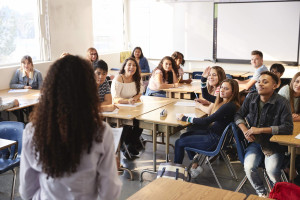
The challenges are real and the stakes are high. Students and the public are increasingly fed a diet of misinformation and polarized points of views that confirm their biases. But this pressure-cooker scenario doesn’t have to fill teachers with anxiety, uncertainty, or fear. Teachers at heart desire to engage with students around these topics and prepare them for their roles, rights, and responsibilities as citizens, and they can do so with safety, fair-mindedness, and love.
For teachers to wade into these spaces requires both vulnerability and skill. “Vulnerability is not knowing victory or defeat, it’s understanding the necessity of both; it’s engaging. It’s being all in,” says researcher Brené Brown. Her words remind us we must fail to succeed. Brown encourages us to “embrace the suck” and swim through the discomfort of vulnerability to connect with our courage.
To that end, the Rutgers Psychology Department’s Social-Emotional and Character Development Laboratory, led by professor Maurice Elias, has developed the Students Taking Action Together (STAT) Project, with funding from the Einhorn Collaborative. STAT uses research-based social-emotional learning (SEL) strategies to equip teachers to facilitate lessons on contentious issues and problems, while engaging SEL, civic discourse, and social justice topics and meeting curricular standards.
STAT includes instructional strategies that sequentially build both teacher and student confidence and competence to engage in civil discourse. Three research-based strategies provide students in grades 5-12 with opportunities to develop the SEL skills necessary to share their opinions with their classmates and appreciate the diverse perspectives of others. The strategies below are applicable to multiple disciplines and activities across a school, from English language arts to business, after-school club activities, advisory, school discipline, and professional learning. They’re designed to help teachers move into the vulnerable space of facilitating contentious conversations with their students.
1. Co-develop classroom norms
Classroom norms are social agreements that can help structure the environment and set expectations that lay the groundwork for a relationship-centered classroom community, in which students can safely and securely participate in meaningful and often controversial discussions with their peers. For example, norms might include:
- Work to understand other points of view.
- Respect one another even if you disagree. When you disagree with someone, consider asking a question to better understand your classmate’s perspective.
- Treat your classmates how you would like to be treated.
According to researchers Robert Boostrom and John W. Maag, if the classroom represents a microcosm of society, then classroom norms offer students a framework for interpreting the classroom and their role within it. Co-creating this social contract with your students will foster inclusive spaces where they can openly express and critically engage around issues with their peer groups.
In a 2017 review of effective practices for developing norms, researchers Peter Alter and Todd Haydon offer these guidelines to keep in mind:
- Involve students: Encourage your students to take an active and participatory role in the process, such as arriving at your norms via consensus or voting to a certain plurality.
- Focus on the positive: Affirmatively state norms and focus on desired behaviors rather than undesired behaviors, more “thou shalt” than “thou shalt not.”
- Less is more: Limit the list of classroom norms; five typically are sufficient.
- Revisit and revise: View your classroom norms as a working document that requires explicit and ongoing attention. Review the norms with your students periodically and seek out their input as to whether adjustments need to be made.
- Make it work for your students: For older students, refer to the classroom norms as a Class Constitution that all students must sign off on and to which amendments can be made. For younger students, present it as a group agreement in the form of a chart—“How to Treat Classmates”—that is visibly posted in the room.
By setting agreements for participation, norms act as guardrails to help to re-center the default social patterns that can cause upsets and discord. In effect, norms set the table for creating inclusive spaces for vulnerable expression and allow for responsive adjustments to be made when a previous working agreement is no longer sufficient. Through their suggestion to “revisit and revise,” Alter and Haydon remind us how classroom norms are like a barometer we can use to consistently assess and adjust to meet our students’ needs. If you can’t have an open discussion in your classroom, your norms are not working.
2. Facilitate peer opinion sharing with Yes-No-Maybe
The experience of developing a whole set of classroom norms nurtures an environment where students can, safely and securely, learn to express their opinions and regulate their emotions on controversial topics. Building upon the foundation laid by norms, the strategy of Yes-No-Maybe empowers teachers to facilitate a full-class share session.
According to Learning for Justice, having students take a stance on an issue and actively listen to peers as they share their stances are crucial elements of any anti-bias classroom, where the goal is that students feel accepted and validated. This is of particular importance in grades 5-12, as students are increasingly aware of how their peers perceive them and, therefore, are more prone to feelings of self-consciousness when sharing their opinions. Yes-No-Maybe helps students to navigate this discomfort and facilitates rich conversations, in which students share their divergent views on a topic and their classmates respectfully listen, reflect on their peers’ opinions, and consider whether or not those opinions influence their original thinking.
Yes-No-Maybe also embeds opportunities for small group discussion. Have students follow the steps below to implement the Yes-No-Maybe strategy in your classroom:
- Reflect and freely write about your opinions related to a topic (posed as either a statement or a question). For example, “Was the insurrection on the Capitol Building an attack on our democracy?”
- Round one: Take a stance on several neutral statements related to the issue by moving to the location in the room labeled “Yes,” “No,” or “Maybe.” Meet in triads or quartets with students in the same location to share your reasons. One spokesperson from each group will summarize the group’s opinions with the whole class, such as “Maybe, it is possible to take freedom too far,” “No, there are instances when insurrection is justified and this was one of them,” or “Yes, and every individual who breached the Capitol committed a crime.”
- Closely analyze background sources, such as podcasts, articles, excerpts from speeches, and photographs related to the topic.
- Round two: Repeat round one, but this time reflect on whether your opinions have changed on the same statements and share with peers through discussion.
- Engage in a reflective discussion with the whole class to debrief how your perspectives changed, as well as what you learned from engaging in peer opinion sharing.
The Yes-No-Maybe strategy allows students to rehearse expressing their opinion on contentious topics in an informal peer setting. This seems like an easy task, but make no mistake—for adolescents, this is a great act of daring and courage. After students build familiarity with the strategy in round one, the round two and reflection discussions open up a natural opportunity for students to almost spontaneously connect with the vulnerability of shifting their position. This strategy can be used for controversial issues and decisions in history, statements or approaches in books being read, forms of artistic expression now and in the past, and in every other subject area.
3. Build empathy and perspective taking skills with Respectful Debate
The experience of peer opinion sharing, in which students build their comfort in taking a stance on issues in front of their peers and learn that shifting their beliefs and opinions based on new information is both natural and acceptable, lays the foundation for empathic, respectful debate. The Respectful Debate strategy introduces students to the more complex and nuanced skill of establishing and defending an informed position on a topic while empathically listening to opposing views. The strategy also provides ample opportunities for students to practice their emotional regulation skills.
Respectful Debate deviates from traditional classroom debate in that it counters students’ tendency toward interpreting information in such a way that it supports their preexisting beliefs by having them use the “consider the opposite” strategy. With this strategy, students must not only defend the position that aligns with their preexisting beliefs but also argue the side that they oppose, in an effort to expand their perspectives.
Students are divided into two groups and assigned either the “pro” or “con” side of the debate. After the teacher poses the controversial statement that frames the debate, they are given some time to critically review background sources and generate ideas in support of their position. The first round of the debate ensues, in which the “pro” and “con” sides present their respective arguments and their opponents engage in active listening to summarize their main points. Using the same debate statement, the “pro” side and “con” side switch to engage in perspective taking. Finally, students engage in a whole class conversation to debrief the impact of perspective taking on their original positions.
Given that Respectful Debate brings the potential to surface strong emotions, please keep the following tips in mind to address peer conflict. We urge that you do not shy away from these experiences due to the intense emotions that they may provoke, but instead be prepared with how to effectively handle them. In our experience, instances of emotions getting out of control have been quite rare…in part because of the norms that Respectful Debate is built upon.
- Acknowledge emotions, review class norms, and problem-solve.
- Acknowledge the feeling in the room.
- Call for a break in the process and have students quickly write down or draw what they are currently feeling, thinking, or experiencing. You might want to ensure that all students have a Respectful Debate notebook—paper or electronic—for this purpose, or for individual students to use when they have some strong emotions they want to express and sort out privately.
- Reorient students to the class norms and ask students how empathy or responsible listening might be used to communicate their experiences in a way that encourages understanding.
- Help students focus on solutions, not problems, in conflicts.
This strategy helps navigate the uncomfortable tension between reason and emotion during a debate that is not meant to be won but to promote understanding of the topic. When students swap sides and they assume the opposing side’s argument, they will have their thinking challenged on the topic. The reflection helps students suspend certainty of being right, maintain personal views in the face of learning about different perspectives, and confront the challenge of not arguing, but listening to understand the opposing side’s argument. The self-regulation demanded by this strategy is core to students’ being able to “live with” the strong emotions that controversial topics inevitably evoke if they truly engage with them.
Navigating contentious conversations with these three strategies equips teachers with the skills to step into their vulnerability and engage, not avoid it. They offer teachers the resources to address students’ social-emotional needs to express, process, and pursue the truth, make sense of these events, and understand the complexities of our multicultural democratic society.
Vulnerability is a strength and opens the emotional landscape in the classroom for deep and meaningful learning. A teacher’s vulnerability can inspire students to be vulnerable and connect with others in profound ways. Implementing the strategies will be uncomfortable initially, but they will help students make sense of what they bear witness to in our time. This is the gift we give to students who will serve as future leaders, so they can transform and serve their communities.


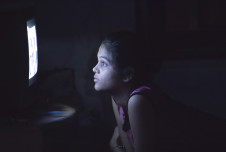
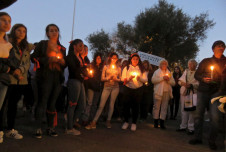
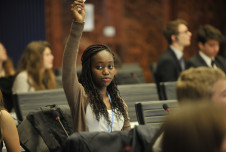
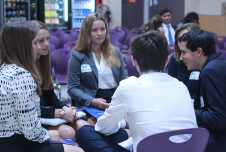
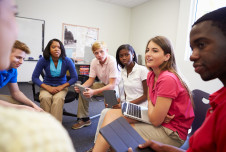

Comments